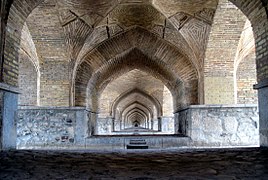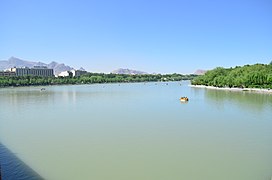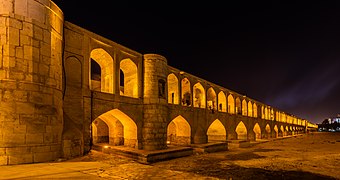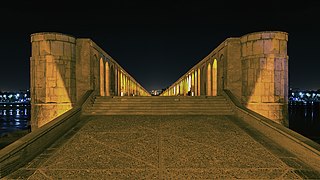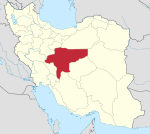Si-o-se-pol: Difference between revisions
m Replace JPG with SVG (via WP:JWB) |
→History: Added content Tags: Mobile edit Mobile web edit |
||
| Line 23: | Line 23: | ||
Si-o-se-pol was built between 1599 and 1602,<ref name="Structurae">{{cite web |url=https://structurae.net/structures/allahverdi-khan-bridge |title=Allahverdi Khan Bridge |work=Structurae |access-date=27 July 2018}}</ref> under the reign of [[Abbas I of Persia|Abbas I]], the fifth [[Safavid dynasty|Safavid]] king ([[shah]]) of Iran. It was constructed under the supervision of [[Allahverdi Khan|Allahverdi Khan Undiladze]], the commander-in-chief of the armies, who was of [[Iranian Georgians|Georgian]] origin, and was also named after him.<ref>{{cite book |url=https://books.google.com/books?id=v4Yr4foWFFgC |title=Iran Under the Safavids |first=Roger |last=Savory |publisher=Cambridge University Press |page=170 |year=2007 |isbn=0521042518}}</ref> |
Si-o-se-pol was built between 1599 and 1602,<ref name="Structurae">{{cite web |url=https://structurae.net/structures/allahverdi-khan-bridge |title=Allahverdi Khan Bridge |work=Structurae |access-date=27 July 2018}}</ref> under the reign of [[Abbas I of Persia|Abbas I]], the fifth [[Safavid dynasty|Safavid]] king ([[shah]]) of Iran. It was constructed under the supervision of [[Allahverdi Khan|Allahverdi Khan Undiladze]], the commander-in-chief of the armies, who was of [[Iranian Georgians|Georgian]] origin, and was also named after him.<ref>{{cite book |url=https://books.google.com/books?id=v4Yr4foWFFgC |title=Iran Under the Safavids |first=Roger |last=Savory |publisher=Cambridge University Press |page=170 |year=2007 |isbn=0521042518}}</ref> |
||
The bridge served particularly as a connection between the mansions of the elite, as well as a link to the city's vital [[Iranian Armenians|Armenian]] neighborhood of [[New Julfa]].<ref name="Iranica"/> |
The bridge served particularly as a connection between the mansions of the elite and the noobs, as well as a link to the city's vital [[Iranian Armenians|Armenian]] neighborhood of [[New Julfa]].<ref name="Iranica"/> |
||
==Structure== |
==Structure== |
||
Revision as of 16:22, 10 September 2019
Si-o-se-pol | |
|---|---|
 | |
| Coordinates | 32°38′40″N 51°40′03″E / 32.6444°N 51.6675°E |
| Crosses | Zayanderud |
| Locale | Isfahan, Iran |
| Characteristics | |
| Design | Arch bridge, double-deck |
| Material | Stone and brick |
| Total length | 297.76 metres (976.9 ft) |
| Width | 14.75 metres (48.4 ft) |
| Longest span | 5.60 metres (18.4 ft) |
| No. of spans | 33 |
| History | |
| Construction start | 1599 |
| Construction end | 1602 |
| Location | |
 | |
The Allahverdi Khan Bridge (Persian: پل اللهوردی خان), popularly known as Si-o-se-pol (Persian: سیوسهپل, lit. '[the] bridge of thirty-three [spans]'),[1] is the largest of the eleven historical bridges on the Zayanderud, the largest river of the Iranian Plateau, in Isfahan, Iran.[2]
The bridge was built in the early 17th century to serve as both a bridge and a dam.[3] It is a popular recreational gathering place, and is one of the most famous examples of Iran's Safavid architecture.
History
Si-o-se-pol was built between 1599 and 1602,[4] under the reign of Abbas I, the fifth Safavid king (shah) of Iran. It was constructed under the supervision of Allahverdi Khan Undiladze, the commander-in-chief of the armies, who was of Georgian origin, and was also named after him.[5]
The bridge served particularly as a connection between the mansions of the elite and the noobs, as well as a link to the city's vital Armenian neighborhood of New Julfa.[1]
Structure
The bridge has a total length of 297.76 metres (976.9 ft) and a total width of 14.75 metres (48.4 ft). It is a vaulted arch bridge consisting of two superimposed rows of 33 arches, from whence its popular name of Si-o-se-pol comes, and is made of stone. The longest span is about 5.60 metres (18.4 ft).[4] The interior of Si-o-se-pol had originally been decorated with paintings, which were often described by travelers to have been erotic.[1]
There is a larger base plank at the start of the bridge, under which the Zayanderud flows, supporting a tea house, which is nowadays abandoned.[citation needed]
Gallery
-
A 17th-century drawing of Si-o-se-pol by Jean Chardin.
-
Benches and tables next to Si-o-se-pol.
-
A view of the arches under Si-o-se-pol.
-
Si-o-se-pol in December 2015.
-
Si-o-se-pol's view of the Zayanderud.
-
The statue of Allahverdi Khan, next to the bridge.
-
Si-o-se-pol at night.
-
Si-o-se-pol's walkway at night.
Transportation
 Chaharbagh Street
Chaharbagh Street Motahari Street
Motahari Street Kamaloddin Esmaeil Street
Kamaloddin Esmaeil Street Chahar Bagh Bala Street
Chahar Bagh Bala Street Mellat Street
Mellat Street Ayenekhaneh Street
Ayenekhaneh Street
 Enqelab Metro Station
Enqelab Metro Station
 Si-o-se Pol Metro Station
Si-o-se Pol Metro Station
References
- ^ a b c Babaie, Sussan; Haug, Robert (5 April 2012) [15 December 2007]. "Isfahan x. Monuments (5) Bridges". In Yarshater, Ehsan (ed.). Encyclopædia Iranica. 1. Vol. XIV. New York City: Bibliotheca Persica Press. Retrieved 25 September 2015.
- ^ Wagret, Paul (1977). Iran. Geneva: Nagel Publishers. p. 226. ISBN 2-8263-0026-1.
- ^ "Drought poses no threat to Isfahan's Si-o-Se-Pol: official". Tehran Times. 25 December 2017.
- ^ a b "Allahverdi Khan Bridge". Structurae. Retrieved 27 July 2018.
- ^ Savory, Roger (2007). Iran Under the Safavids. Cambridge University Press. p. 170. ISBN 0521042518.
External links



